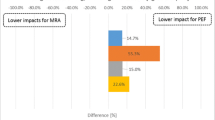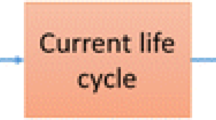Abstract
Purpose
End-of-life (EoL) recycling poses a challenge to many practitioners today due to the availability of different calculation approaches and the lack of scientific consensus, which is fueled by academic research and vested industry interests alike. One of the main challenges in EoL modeling is the credible calculation of the appropriate recycling credit in open-loop and closed-loop situations.
Methods
We believe that part of the challenge is caused by a lack of understanding of the underlying recycling paradigm, which refers to the meaning that is assigned to the recycling credit. Referred to as “system expansion through substitution” and “future displacement of primary production,” the two predominant paradigms are delineated from each other followed by a discussion of their remaining challenges.
Results and discussion
Based on these considerations, we propose a revised paradigm based on embodied burdens that is able to alleviate many of the most pressing issues associated with material recycling in attributional life cycle assessment.
Conclusions
With this discussion paper, we look forward to a productive and lively debate on the matter.




Similar content being viewed by others
Notes
The overall recycling rate (collection rate times recycling yield) of 80% does not lead to a credit of exactly 80% of the manufacturing burden in the example for neither scenario due to the way scrap inputs into the worldsteel inventories affect the mass flows under the net scrap approach (see the Electronic Supplementary Material).
From the perspective of the scrap-receiving producer, the price paid should cover more than just the collection, pre-treatment, distribution, and profit margin of the EoL value chain; first and foremost, there needs to be a cost associated with the material itself for the end-of-waste stage to be reached.
References
Allacker K, Mathieux F, Pennington D, Pant R (2017) The search for an appropriate end-of-life formula for the purpose of the European Commission Environmental Footprint initiative. Int J Life Cycle Assess 22(9):1441–1458
Atherton J (2007) Declaration by the metals industry on recycling principles. Int J Life Cycle Asssess 12(1):59–60
Attanasio A et al (2017) Towards greener concrete: the challenges of SUS-CON project. In: Hordijk D, Luković M (eds) High tech concrete: where technology and engineering meet. Springer, Berlin, pp 2373–2381
Baitz M et al (2013) LCA’s theory and practice: like ebony and ivory living in perfect harmony? Int J Life Cycle Assess 18(1):5–13
Bohnacker J (1998) Einfluß von Recyclingverfahren auf die umweltliche Produktbilanz. Shaker Verlag, Aachen
Bontempi E (2017) A new approach for evaluating the sustainability of raw materials substitution based on embodied energy and the CO2 footprint. J Clean Prod 162:162–169
CEN (2012) EN 15804:2012—sustainability of construction works—environmental product declarations—core rules for the product category of construction products. Brussels: European Committee for Standardization
den Hollander MC, Bakker CA, Hultink EJ (2017) Product design in a circular economy—development of a typology of key concepts and terms. J Ind Ecol 21(3):517–525
Densley Tingley D, Davison B (2012) Developing an LCA methodology to account for the environmental benefits of design for deconstruction. Build Environ 57:387–395
Finkbeiner M, Neugebauer S, Berger M (2013) Carbon footprint of recycled biogenic products: the challenge of modelling CO2 removal credits. Int J Sustain Eng 6(1). https://doi.org/10.1080/19397038.2012.663414
Frischknecht R (2010) LCI modelling approaches applied on recycling of materials in view of environmental sustainability, risk perception and eco-efficiency. Int J Life Cycle Assess 15(7):666–671
Han M et al (2017) Global water transfers embodied in Mainland China’s foreign trade: production- and consumption-based perspectives. J Clean Prod 161:188–199
Heijungs R (2014) Ten easy lessons for good communication of LCA. Int J Life Cycle Assess 19:473–476
ISO (2006a) ISO 14040—environmental management—life cycle assessment—principles and framework. Geneva: International Organization for Standardization
ISO (2006b) ISO 14044—environmental management—life cycle assessment—requirements and guidelines. Geneva: International Organization for Standardization
ISO (2012) ISO/TR 14049—environmental management—life cycle assessment—illustrative examples on how to apply ISO 14044 to goal and scope definition and inventory analysis. Geneva: International Organization for Standardization
Koffler C (2014) Reply to “Ten easy lessons for good communication of LCA” by Reinout Heijungs. Int J Life Cycle Assess 19:1170–1171
Koffler C, Florin J (2013) Tackling the downcycling issue—a revised approach to value-corrected substitution in life cycle assessment of aluminum (VCS 2.0). Sustainability 5:4546–4560
Koffler C, Wang JM (2017) Comment on “Toward estimating displaced primary production from recycling—a case study of U.S. aluminum” by Zink et al. (2017). J Ind Ecol. doi:https://doi.org/10.1111/jiec.12656
Krinke S, Bossdorf-Zimmer B, Goldmann D (2005) Executive summary—life cycle assessment of end-of-life vehicle treatment. Volkswagen AG, Wolfsburg
Lindeijer E (1994) Allocating recycling for integrated chain management: taking account of quality losses. SETAC, Brüssel
Mengarelli M et al (2017) End-of-life modelling in life cycle assessment—material or product-centred perspective? Int J Life Cycle Assess 22(8):1288–1301
Popper KR (1972) Objective knowledge: an evolutionary approach. Revised edition ed. Oxford University Press, Oxford
Schrijvers D, Loubet P, Sonnemann G (2016) Developing a systematic framework for consistent allocation in LCA. Int J Life Cycle Assess 21(7):976–993
Sitang L, Huiqiang L (2005) Quantitative assessment on the embodied environmental impact of concrete with or without fly ash. J Wuhan Univ Technol 20(3):99–103
Sodersten C-J, Wood R, Hertwich EG (2017) Environmental impacts of capital formation. J Ind Ecol. https://doi.org/10.1111/jiec.12532
Talens Peiro L, Ardente F, Mathieux F (2017) Design for disassembly criteria in EU product policies for a more circular economy: a method for analyzing battery packs in PC-tablet and subnotebooks. J Ind Ecol 21(3):731–741
The Quartz Project, 2015. The Quartz Common Products Database. [Online] Available at: http://quartzproject.org/[Accessed 10 July 2017]
Vadenbo C, Hellweg S, Astrup TF (2016) Let’s be clear(er) about substitution—a reporting framework to account for product displacement in life cycle assessment. J Ind Ecol. https://doi.org/10.1111/jiec.12519
Weidema BP (2003) Market information in life cycle assessment, Copenhagen. Danish Environmental Protection Agency
Weidema BP (2017) In search of a consistent solution to allocation of joint production. J Ind Ecol. https://doi.org/10.1111/jiec.12571
Werner F (2002) Treatment of aluminium recycling in LCA—development and evaluation of the value-corrected substitution procedure. EMPA, Duebendorf
Wilts H et al (2016) Benefits of resource efficiency in Germany, Wuppertal: Wuppertal Institute worldsteel (2011) Life Cycle Assessment Methodology Report, Brussels: worldsteel association
worldsteel (2011) Methodology report — Life cycle inventory study for steel products. worldsteel association, Brussels. Available at https://www.worldsteel.org/en/dam/jcr:6a222ba2-e35a-4126-83ab-5ae5a79e6e46/LCA+Methodology+Report.pdf. Accessed: Oct. 12, 2017
Wu X, Chen G (2017) Energy and water nexus in power generation: the surprisingly high amount of industrial water use induced by solar power infrastructure in China. Appl Energ 195:125–136
Zink T, Geyer R (2017) Circular economy rebound. J Ind Ecol 21(3):593–602
Zink T, Geyer R, Startz R (2015) A market-based framework for quantifying displaced production from recycling or reuse. J Ind Ecol 20(4):719–729
Zink T, Geyer R, Startz R (2017) Toward estimating displaced primary production from recycling—a case study of U.S. aluminum. J Ind Ecol. https://doi.org/10.1111/jiec.12557
Author information
Authors and Affiliations
Corresponding author
Additional information
Responsible editor: Mary Ann Curran
Electronic supplementary material
ESM 1
(XLSX 177 kb)
Rights and permissions
About this article
Cite this article
Koffler, C., Finkbeiner, M. Are we still keeping it “real”? Proposing a revised paradigm for recycling credits in attributional life cycle assessment. Int J Life Cycle Assess 23, 181–190 (2018). https://doi.org/10.1007/s11367-017-1404-x
Received:
Accepted:
Published:
Issue Date:
DOI: https://doi.org/10.1007/s11367-017-1404-x




